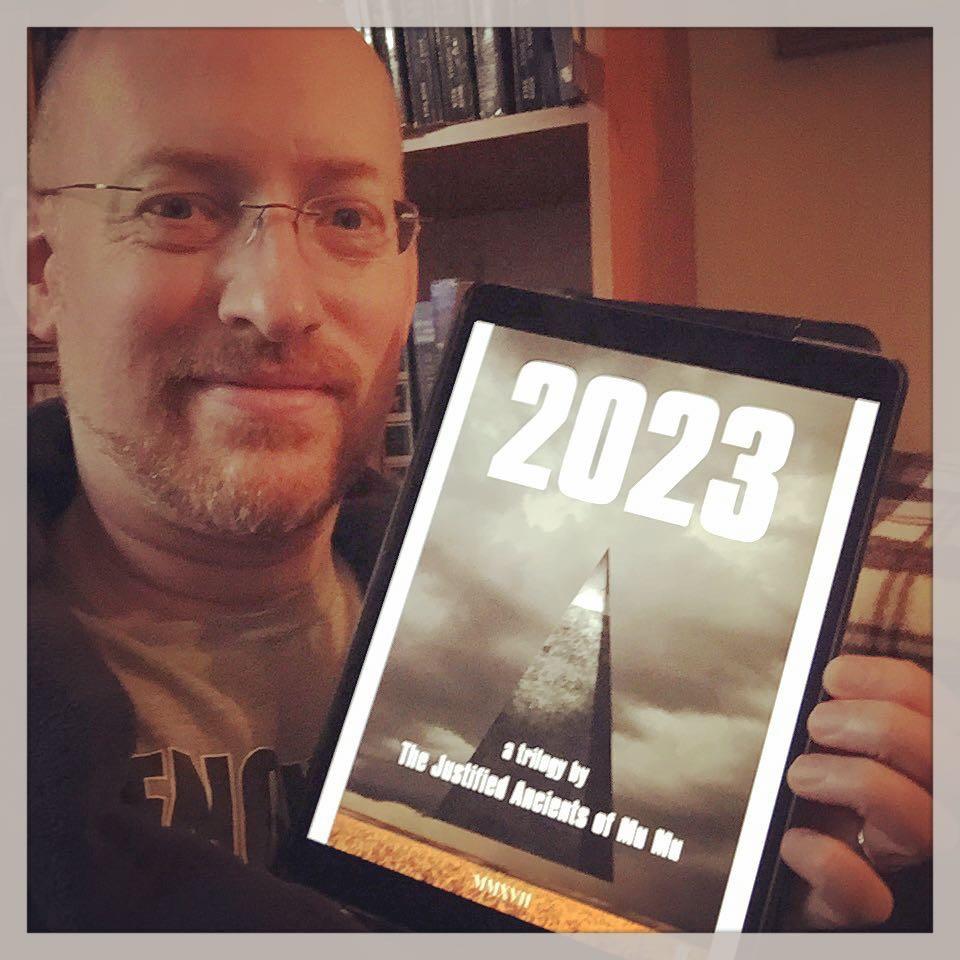Spooky #lego #halloween graveyard!

Enthusiastically Ambiverted Hopepunk
Spooky #lego #halloween graveyard!

Eating candy, building #legos, and watching #strangerthings season two. Happy #Halloween! 🎃💀👻

The misty fog makes for perfect Halloween spiderwebs this morning.

Book forty-three of 2017: 2023, by The Justified Ancients of Mu Mu (furthermore known as The JAMs, a.k.a. The KLF, a.k.a. Jimmy Cauty and Bill Drummond). ⭐️⭐️⭐️

Just a few hours until #LordsofAcid!

Something for the Trek fans in my circles who either are watching Discovery or don’t mind spoilery stuff: I’ve just finished reading Desperate Hours, the first DIS tie-in novel. It’s set a year before the opening of DIS and a year after Pike’s Enterprise visits Talos IV (as seen in “The Cage”), and involves both the Shenzhou and the Enterprise under Captain Pike’s command. As such, it has to find a way to address some of the more obvious differences between the shows, and it doesn’t do a bad job, with some attempts at explanation, and some simple knowing wink-and-nod acknowledgements.
It’s also worth noting that according to the people behind DIS’s media tie-ins, this and any forthcoming DIS books and comics can be considered canon unless the show contradicts it.
Here are a few key things I noticed. Obviously, spoilers from here on down (though I’m trying to avoid spoilers for the actual plot of the book, and am concentrating just on the areas where the old and new overlap)…
p. 79:
Unlike many other types of starship in the fleet, Constitution-class vessels had no ready rooms for their captains. Most days, Pike didn’t miss having a ready room—except for those occasions when he received a classified transmission above the security clearance of his bridge crew, compelling him to return to his quarters to receive it.
p. 93:
In Georgiou’s experience, it was a bad idea for the captain to appear distracted on the bridge…. Thus had Starfleet adopted the tradition of a captain’s “ready room.” Though not all ships of the line had incorporated the concept, many had, and they were proving to be increasingly popular with commanding officers throughout the service. Georgiou was one of them.
p. 97:
In front of the bridge’s forward view of Sirsa III appeared a life-sized hologram of the commanding officer of the Enterprise. A grave expression darkened the human man’s youthful, chiseled features. “Captain Georgiou. I’m Captain Christopher Pike.”
So by this passage and others in the book, the Enterprise does have the holographic communications interface.
p. 97-98:
Responsibility for monitoring the wider theater of operations was actually the duty of Narwani, the junior tactical officer, whose head was encased in a gleaming metallic VR helmet designed for that task.
That’s the “Daft Punk” robot-looking character seen on the Shenzhou — not a robot, but an officer in a VR helmet.
p. 106:
Burnham had known Lieutenant Spock when they both were children, but it had been many years since they had seen or even spoken to each other in passing.”
The first mention of Burnham and Spock encountering each other in their youth.
p. 111:
“Time for full disclosure, Mister Spock. Who is the Shenzhou’s XO to you?”
“Her name is Michael Burnham,” Spock said. “She is…a friend of my family.”
Pike was confused. “How well do you know her?”
“She is a few years older than I am, so we rarely moved in the same social or academic circles. If not for her connection to my parents, I would barely know of her at all.”
So Burnham is slightly older than Spock. Also, this is one of Spock’s “technically not lying” statements.
p. 117:
A golden shimmer and a mellifluous droning washed away the familiar grey confines of the Enterprise’s transporter room and delivered Spock to its counterpart inside the Shenzhou. He noticed immediately that the two compartments were laid out very differently. Whereas the Enterprise’s transporter room consisted of a dias with six energizer pads in front of the console, on the Shenzhou the energizer pads were larger and mounted on a curved bulkhead behind a semicircular dais. Also of note to Spock was the darker ambience of the Shenzhou’s transporter room and its more spacious nature.
p. 118:
He fell in at her side as they left the transporter room and strolled the corridors of the Shenzhou. Once again Spock noted marked differences in the interior of the Walker-class ship from that of the Enterprise. Aboard the Shenzhou the grays were darker, and the bulkheads’ orientations more angular. It was clear to him that the two ships had been designed and constructed in different eras, according to very different aesthetic standards. Such drastic changes in a short span of time were not unusual among the humans of Earth, though it had proved a constant source of bemusement among their Vulcan and Andorian allies.
p. 119:
The doors closed, and the lift car shot into motion with hardly any sensation of movement. Spock noted the profusion of display screens that ringed the top of the lift car, and the complexity of the interface screens placed at eye level. He preferred the austerity of the Enterprise’s turbolifts, with their dearth of distractions and an optional control handle.
p. 145:
He stood at attention while he waited for the golden scintillation of the beam to resolve into the familiar shape of a humanoid female wearing a pale beige turtleneck tunic, black trousers, tall boots, and a small backpack.
First mention of the differences in uniform styles.
p. 157:
Gant and his team from the Shenzhou wore dark blue Starfleet utility jumpsuit uniforms with black trim, while the Enterprise team members sported pale gold or light blue jerseys over black trousers—a new uniform style that so far had been issued exclusively to the crews of Starfleet’s vaunted Constitution-class starships.
p. 273:
“What if we devised an automated delivery system, such as a drone, to deliver the gas?”
“If it’s remote controlled,” Gant said, “the command system would be crippled by the same scrambling field that’s blocking our transporters. And as I’m sure you recall, autonomous robotic attack systems—”
“Are prohibited by Federation law,” Saru said, finishing the citation. “A most nettlesome restriction, if you ask me.”
Ensign Fan turned away from the communications console. “That’s what the people of Earth used to think, right up until World War III. Every time I think about those killer ‘bots in the streets of Paris, I get a shiver down my spine.”
Interesting bit of in-universe history.
p. 330:
Gant pressed his index finger to his panel’s firing control. Outside the center viewport, a fierce storm of energy pulses erupted from the Shenzhou’s numerous phaser batteries. the barrage tore holes in the Juggernaut’s shields, which crackled into view like a tattered bubble of sickly green light. Then a pair of steady blue beams from the Enterprise pierced the green cocoon, sliced into the goliath, and flensed off large pieces of its hull.
The fearsome power of the Constitution-class starship’s state-of-the-art weaponry drew a gasp from Oliveira. “My God,” she said. “The new type-ten phaser banks can do that?”
“And a lot more,” Georgiou said, succumbing to a small twinge of envy.
p. 352:
Blue-shirted medical crewmen from the Enterprise parted from their white-uniformed counterparts from the Shenzhou….
p. 356:
“You seem different since you got back.”
Her assertion aroused Spock’s curiosity. “In what regard?”
“You seem…I don’t know. Older? No—calmer than you did before.” She tilted her head as she continued to study him and collect her thoughts. “You present yourself in a way that feels more centered. Better balanced.” Her smile broadened to a grin. “You have gravitas now.”
Recognizing the difference in Nimoy’s portrayal of Spock between “The Cage” and later episodes.
So that’s it. I enjoyed the book, and the nods to trying to explain — or at least recognize and maybe rationalize a bit — the differences between two series set only a decade apart, but produced half a century apart, were a lot of fun.
Now that I’ve let the first two episodes of ST:DIS bounce around in my head overnight, and have seen a few reviews and bits of commentary, it’s time to toss my two cents in.
I’ll start with non- or less-spoilery stuff, getting more spoilery as things go along, so those who haven’t seen the premiere episodes can bail out before bigger spoilers pop up.
And, of course, these are merely my thoughts and opinions on all of this. YMMV.
Yes, Discovery is CBS All Access only (aside from the initial broadcast of the first of the two episodes released on Sunday). Yes, a lot of people are upset about this, for varying degrees of “upset”.
For me, it’s not a big deal, for a few reasons.
Put that way, that could be true — but then, just how true it is depends on all sorts of factors. I’m of the opinion that it’s a badly stated argument, though, because it’s not $6 or $10 a month for a single show, it’s for access to everything CBS offers under All Access. As it stands right now, that includes every Star Trek episode produced to date (TOS, TAS, TNG, DS9, VOY, ENT, and DIS), along with a number of other shows.
It may well be true that there are people out there who are only interested in DIS; for those people, the fee may seem high. But even if they’re only interested in one show, it’s still true that they’re getting access to a lot more than that, even if they choose to never take advantage of that. In my particular situation, while I already have TOS, TAS, TNG, and DS9 in my own collection at home, All Access is also giving me easy access to VOY and ENT (only one of which actually interests me, admittedly, as I’ve just finished off VOY and didn’t think much of it) in addition to DIS and the After Trek post-show show (which I haven’t sampled yet). Outside of the Trek universe, there are a number of other shows that my wife and/or I have enjoyed in the past and might want to continue watching or revisit (The Amazing Race, Cheers, Frasier, Madam Secretary, The Twilight Zone), that are related to shows we’ve enjoyed in the past (NCIS precursor JAG), or that we haven’t tried yet but might want to give a shot (Elementary, The Good Wife).
So for us, $6 a month (or even $10 a month, if we choose to move up to that tier) doesn’t seem terribly unreasonable. But that’s just us. If the only thing CBS has available on All Access that interests you is Star Trek, and if you’ve already watched (or already own) everything other than DIS, then sure, this might not be a good value.
Yes, and this is one area where I definitely wish All Access was better. I’d absolutely be happier if there was a single no-commercials option, rather than the current $6 “limited commercials” or $10 “no commercials unless we feel like it” option.
At the same time, I realize that TV is expensive — particularly TV like DIS, which is reportedly one of the most expensive series in TV history, on the order of $8 million per episode. And while cynical, it’s not entirely untrue to see the shows we watch as nothing but filler designed to keep our butts in the seats in between the advertisements that provide the majority of the income for the studios. Like it or not, advertising is the bottom line that allows us to enjoy much of the media we consume, and while I prefer not having to sit through advertisements (strongly enough that I stopped watching TV for close to a decade in the late ’90s and early ’00s, as there wasn’t enough content I was interested in to make sitting through the commercials worthwhile), I also recognize that without advertising dollars underwriting things, we’d have a lot less media to choose from.
What bothered me the most last night as I watched DIS was not that there were commercials (particularly as I wasn’t paying for the higher-priced “commercial free” tier), but that the same commercials were repeated over and over, and that they were so loud compared to the show. I found the “happy drivers” commercial with Neil Diamond’s “Sweet Caroline” amusing the first time, increasingly annoying each additional time; the same was true for the rest. And though the FCC claims that commercials have been required to be the same average volume as the programming since 2012, that sure doesn’t seem to be the case in practice.
So for me, commercials are an annoyance that I’d rather not have, but I’ll cope with gritting my teeth and dealing with the inanity and having to keep the volume control nearby if it means we get a better show in the end.
Of course, if you have the magical solution that allows CBS to produce big-budget TV without either running commercials or asking us to pay for it, I’m sure they’d be happy to know.
(As a side note, if I had the time and expertise, I would love to host a podcast focusing on the technology of DIS and comparing/contrasting/retconning it with the rest of the Trek universe. Said podcast, would, of course, be named “DISCOtech”, and the intro music would be edits of Meco’s “Star Trek Medley”. Since I don’t have the time or expertise to do this, if someone sees this and decides to run with the idea, you’re free to do so; I’d just appreciate a call-out.)
So, I’ve seen many people up in arms about the design and the technology of DIS, particularly noting that though placed a decade before TOS and in the original timeline (and yes, it is in the original/”prime” timeline, not the Abrams-verse Kelvin timeline), it looks far more like the Abrams-verse films than the classic TOS episodes.
To which I say, well, yeah, no kidding. TOS was produced in the 60s, with the tech and budgets they had available then. DIS is being produced now, with the tech and budgets we have now. We in the present-day real world already enjoy technology that is in many ways advanced over much of what we saw as “futuristic” in TOS. To expect a modern show to try limit its production design to that of the 1960s is silly at best, and likely a sure-fire recipe for a failure of a show.
I’m very curious as to what people think DIS should have done — what would be the “right” way to present a show set two and a half centuries after where we are now, but a single decade before a show produced on a 1960s TV budget? Would we really expect the show to find some convoluted reason why over the next two hundred and fifty years, we suddenly decide to ditch touchscreens, adaptive UIs, and ultra-miniaturized electronics in favor of CRTs and physical toggle switches?
(Though, I’ll admit, it would have been interesting if the producers had come up with some heretofore unknown period of technological regression between ENT and DIS to explain why the entire DIS-era galaxy was using pseudo-60s-era technology and production design. Because nobody would have had any problems with shoehorning that into the canon!)
Real-world technology changes constantly and quickly, and to expect our futuristic media to slavishly abide by the restrictions that the real-world technology of the past imposed is just silly.
(And another aside. There’s a question that iO9 asked a few years ago that this silly debate keeps reminding me of: Why doesn’t anyone in Star Trek use social media/text messages? The real answer, of course, is that it’s a form of communication that rose to prominence after the show was aired, but viewed through the lens of today’s technology, it really does seem bizarre that by the time any version of Trek comes to pass, we will have entirely given up something as simple and useful as text messaging.)
For me, the most important thing about Trek is always the stories. The presentation is always a product of its time, for good and for ill: we enjoy the simplistic design of TOS Trek while also recognizing how well they did for their time, we recognize the areas where they broke new ground (diversity and inclusion, tackling real-world subjects through the lens of science fiction, and basically doing all the “social justice warrior” stuff that so many sad people — including, sadly, William Shatner himself — complain about) while also recognizing where they stumbled (including no few incidents of cringeworthy sexism, ranging from TOS to the Abramsverse films). But the stories, the optimism, and the hope for humanity and the future is always the heart of Star Trek.
So if DIS looks like a product of today than a product of the 1960s? I’m entirely okay with that, and welcome that. New viewers — who, make no mistake about it, are as much in CBS’s target as all of us “old school” fans — are going to be a lot more comfortable with that decision, too. As Kevin Church said:
As much as I love TOS and its design, you have to update it to meet modern audience expectations, especially if you’re trying to get a new audience, which is what CBS needs. They’ve gotten about as much revenue as they can from the previous series and a cash infusion is going to have to happen to keep the franchise afloat for them.
However — and I’ll admit right off the bat that this line is going to be a somewhat fuzzy one, open to interpretation and argument — I do have quibbles with some of the technology shown as being in use in DIS and how it fits in to the established Star Trek technological universe.
My rationalization for this boils down to the difference between the technology of the production of the show (the overall look and feel of the sets, props, effects, etc.) and the technology of the universe of the show (warp drive, transporters, subspace communication, etc.). Real world technology and methods that affect how the show looks in comparison to the other shows I’m fairly tolerant of; fictional world technology that doesn’t jibe with what’s been established in the other shows, I’m less tolerant of.
Y’know. Geeks. Pick your battles. (And as I’ve said frequently, part of what I love about being a SF geek, and a Trek geek in particular, is long-ranging, in-depth, passionate arguments about absolutely ridiculously inconsequential pieces of trivia. So there’s that, too.)
The big thing that stood out to me along these lines was the holographic communication used on the Shenzhou. This is a very different style of communication than we’ve seen in most Trek to date; I actually didn’t remember seeing holographic communication in the Trek universe, though Memory Alpha notes that it was seen a few times on DS9, which I’d simply forgotten about.
Amusingly, the article has already been updated to include its use in DIS, noting that the Shenzhou has “an early version of this type of device”. However, I’d argue that the technology shown in DIS can be seen as “early” only in that it has the same blue-tinged, see-through, “ghostly” presentation that we’re used to seeing in /ahem/ that other SF universe, rather than the realistic, solid-appearing holodeck-style holograms that appear to have been used on DS9 (judging by this screenshot, since my memory is faulty here). Otherwise, it seems more advanced in how the characters can interact with each other during holographic communication, even in ways that don’t really make sense, including Sarek walking around Burnham and sitting on the edge of a desk in the room — wouldn’t this require his having a room that just happened to have the right furniture (or something to sit on) in just the right spot?
So this is once instance where an in-universe discontinuity was far more jarring to me than the overall stylistic differences between TOS and DIS. (Riker seems to agree with me, even!)
As for the Klingons themselves: yes, they look different in both the physical makeup and the design of their ships. Yes, right now, that’s difficult to reconcile with established Klingon appearances. And for the moment, at least, I’m willing to let that slide.
Klingons have changed — repeatedly — over the course of Trek as it is. We all know that the only real reason the Klingons original changed appearance was because TMP had a bigger budget than TOS did, and the Klingons got upgraded along with everything else. For years, there were essentially two ways of looking at the change: either Klingons had always had the ridges, but 60s TV production didn’t have the budget to reflect this, or there was a physical change for some unknown reason. I was good with either; the latter was fun to speculate about (some earlier Trek literature posited that the intercepted transmission from the Klingons facing off with V’Ger was the first time that Starfleet saw the “true” appearance of Klingons). Yes, the Augment virus solved the Klingon forehead problem; I just kind of wish it hadn’t actually been solved.
And I’d argue that if the Augment virus hadn’t been introduced, if ENT had just let the change in appearance stand (either by going with TOS-style Klingons (though, hopefully somewhat less racially problematic, if that could be done) or by just going with ridged Klingons and accepting that certain elements of fandom would have fits), we might have less grumbling about the new revisions to their appearance. I’m sure it wouldn’t be nonexistent, but at least we’d have established discontinuities to work with, rather than an established continuity that the present design doesn’t seem to be compatible with.
For myself, I’m willing to just go with “new show, new Klingons” for the moment, and shrug off the weirdness. No, it doesn’t make sense (and, heck, it could easily be argued that my acceptance of this doesn’t even fit with my above distinction between accepting real world production differences affecting tech presentation but grumbling about in-universe tech changes, since this is a real-world production change that drastically conflicts with established in-universe continuity). But for me, at least, it doesn’t make sense in a way that I’m willing to work with for now. For whatever sense that makes.
(By the way, now we’re getting more into spoiler territory. Just so’s you know.)
For the moment, at least, I’m optimistic, though not without some reservations.
There was a lot of talk during the run-up to the show about how there were reasons why both the show and the ship are called “Discovery”, that the old goals of exploration, of “seeking out new life and new civilizations” was going to be a large part of the show, that the Discovery itself is an exploration vessel, that the hope and optimism of Trek were going to be part of the show. And I think we got at least some of that, particularly during the first of the two episodes. However, the second episode, and therefore the overall feel of the first two, was very battle-focused, and it’s also been made clear that war with the Klingons was going to be major ongoing plotline for this first season.
Now, I’m not entirely opposed to learning more about Starfleet’s history with the Klingons (let alone learning more about the DIS take on the Klingons). But at the same time…look, as much as I liked Ron Moore’s Battlestar Galactica reboot, that’s not what I want Star Trek to be. Yes, Trek has often had battles and militaristic plotlines, often used to very good effect, but they were always a part of the whole, and I’d be disappointed if DIS ended up shifting so far towards the conflict with the Klingons that it lost sight of what, for many of us, has made Trek such an enduring part of our lives.
As others have noted, I do think it might be worth considering these first two episodes not really to be the pilot episode(s) of DIS, but as a prequel of sorts; something of an “origin story” for Burnham and for the state of the Star Trek universe for DIS. There’s a lot that changes between the end of these two episodes and the beginning of next week’s episode; as it is, we have yet to be introduced to the Discovery itself, let alone its captain or the majority of its crew (we know Burnham and Saru will end up on the Discovery, and promo images make it appear that the red-headed helm/conn officer might as well). Several of the primary characters of the first two episodes are dead (one — Georgiou — I expected; one — T’Kuvma — I did not). Burnham has been sentenced to life imprisonment for her mutiny. Lots of shifts going on, enough that it can be argued that next week’s episode will be the true pilot.
The preface is complete, time to start chapter one.
I’m hoping it’s a good one.
Our local Fred Meyer has the (ahem) recently discovered Rhino Dragon in stock! 🦏🐲 😆

Sometime between July 25th and September 21st, I thought this stuff was interesting. You might think so too!
One of these days we need to have a game night… #munchkin #munchkinshakespeare
